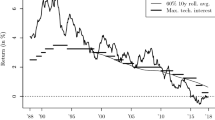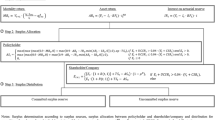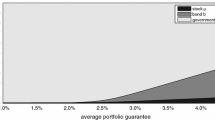Abstract
Participating life insurance contracts are policies that provide dividends (participation bonuses) based on the insurer’s financial performance. While these products are popular, there exists a gap in the literature for the analysis of these contracts under a stochastic setting. This paper fills this gap by proposing methods to (i) determine performance bonuses, (ii) compute the fair premium of the contract, and (iii) perform risk measurements for participating contracts in a realistic stochastic environment. The specific case of a fixed premium endowment participating contract, where the annual premium remains constant while benefits increase stochastically, is considered. We extend both the variable benefits life insurance approach of Bowers et al. [9] and the compound reversionary bonus mechanism presented in Booth et al. [8] and Bacinello [2] to a stochastic financial market (including stochastic interest rates) and stochastic mortality framework. Monte Carlo simulations provide insight about the sensitivity of premiums to contract specification and the evolution over time of both benefits and risks faced by the insurer.





Similar content being viewed by others
Notes
Although the account value \({\mathcal {A}}_{k+1}\) given by (3.1) is not bounded below by zero and could in theory become negative, such situation is not encountered in the simulation experiments present in subsequent sections. Thus, modifications to (3.1) would ensure non-negative account values are not considered.
Here we assume that the risk-free rate is used as the so-called technical rate in Bacinello [2].
Such table is used for illustrative purposes. In practice, it would be desirable to devise a table compatible with changes in mortality expectations in more recent years which incorporate for instance the impact of the COVID-19 pandemic discussed in Schöley et al. [30]. Such endeavour is left out-of-scope.
The shadow reserve, therefore, depicts the market value of future cash flows to the insurer, not their actual expected value.
References
Augustyniak M, Godin F, Hamel E (2021) A mixed bond and equity fund model for the valuation of variable annuities. ASTIN Bulletin: The Journal of the IAA 51(1):131–159
Bacinello AR (2003) Pricing guaranteed life insurance participating policies with annual premiums and surrender option. North American Actuarial Journal 7(3):1–17
Bacinello AR, Ortu F (1994) Single and periodic premiums for guaranteed equity-linked life insurance under interest-rate risk: the “lognormal+ Vasicek” case. In Financial Modelling, pages 1–25. Springer
Bacinello AR, Persson S-A (2002) Design and pricing of equity-linked life insurance under stochastic interest rates. The Journal of Risk Finance 3(2):6–21
Bauer D, Kiesel R, Kling A, RußJ (2006) Risk-neutral valuation of participating life insurance contracts. Insurance: Mathematics and Economics 39(2):171–183
Bernard C, Le Courtois O, Quittard-Pinon F (2005) Market value of life insurance contracts under stochastic interest rates and default risk. Insurance: Mathematics and Economics 36(3):499–516
Black F (1976) Studies of stock market volatility changes. 1976 Proceedings of the American statistical association business and economic statistics section
Booth P, Chadburn R, Haberman S, James D, Khorasanee Z, Plumb RH, Rickayzen B (2020) Modern actuarial theory and practice. CRC Press
Bowers N, Gerber H, Hickman J, Jones D, Nesbitt C (1997) Actuarial Mathematics. Society of Actuaries
Briys E, De Varenne F (2001) Insurance: From underwriting to derivatives. In Financial Innovations and the Welfare of Nations, pages 301–314. Springer
Chang H, Schmeiser H (2022) Life insurance surrender and liquidity risks. Quantitative Finance 22(4):761–776
Christensen JH, Diebold FX, Rudebusch GD (2011) The affine arbitrage-free class of Nelson-Siegel term structure models. Journal of Econometrics 164(1):4–20
CIA (2014) Canadian pensioners’ mortality. Canadian Institute of Actuaries. Document 214013. https://www.cia-ica.ca/docs/default-source/2014/214013e.pdf
Eghbalzadeh R, Godin F, Gaillardetz P (2022) The discrete-time arbitrage-free Nelson-Siegel model: A closed-form solution and applications to mixed funds representation. Available at SSRN 4263048
Fan K (2013) An FFT approach to price guaranteed minimum death benefit in variable annuities under a regime-switching model. Chinese Journal of Applied Probability and Statistics 29(5):531–546
Gatzert N, Holzmüller I, Schmeiser H (2012) Creating customer value in participating life insurance. Journal of Risk and Insurance 79(3):645–670
Gatzert N, Kling A (2007) Analysis of participating life insurance contracts: A unification approach. Journal of Risk and Insurance 74(3):547–570
Grosen A, Jørgensen PL (2000) Fair valuation of life insurance liabilities: The impact of interest rate guarantees, surrender options, and bonus policies. Insurance: Mathematics and Economics, 26(1):37–57
Haberman S, Ballotta L, Wang N (2003) Modelling and valuation of guarantees in with-profit and unitised with profit life insurance contracts. Cass Business School Research Paper
Miltersen KR (2002) Minimum rate of return guarantees: The Danish case. Scandinavian Actuarial Journal 4:280–318
Hardy M (2003) Investment guarantees: modeling and risk management for equity-linked life insurance, vol 215. John Wiley & Sons
IASB (2017) Basis for conclusion on IFRS 17 insurance contracts. Technical report, International Accounting Standards Board. https://www.runi.ac.il/media/hjfdfstv/basisforconclusions.pdf
Jia B, Wang L, Wong HY (2023) Machine learning of surrender: Optimality and humanity. Journal of Risk and Insurance
Kijima M, Wong T (2007) Pricing of ratchet equity-indexed annuities under stochastic interest rates. Insurance: Mathematics and Economics 41(3):317–338
Lin XS, Tan KS, Yang H (2009) Pricing annuity guarantees under a regime-switching model. North American Actuarial Journal 13(3):316–332
Nelson DB (1991) Conditional heteroskedasticity in asset returns: A new approach. Econometrica: Journal of the Econometric Society, pages 347–370
Ng AC-Y, Li JS-H, Chan W-S (2011) Modeling investment guarantees in Japan: A risk-neutral GARCH approach. International Review of Financial Analysis 20(1):20–26
Nielsen JA, Sandmann K (1995) Equity-linked life insurance: A model with stochastic interest rates. Insurance: Mathematics and Economics 16(3):225–253
Schmeiser H, Wagner J (2011) A joint valuation of premium payment and surrender options in participating life insurance contracts. Insurance: Mathematics and Economics 49(3):580–596
Schöley J, Aburto JM, Kashnitsky I, Kniffka MS, Zhang L, Jaadla H, Dowd JB, Kashyap R (2022) Life expectancy changes since COVID-19. Nature Human Behaviour 6(12):1649–1659
Tanskanen AJ, Lukkarinen J (2003) Fair valuation of path-dependent participating life insurance contracts. Insurance: Mathematics and Economics 33(3):595–609
Tiong S (2013) Pricing inflation-linked variable annuities under stochastic interest rates. Insurance: Mathematics and Economics 52(1):77–86
Wilkie A (1987) An option pricing approach to bonus policy. In memoriam Anthony P. Limb. Journal of the Institute of Actuaries 114(1):21–90
Zaglauer K, Bauer D (2008) Risk-neutral valuation of participating life insurance contracts in a stochastic interest rate environment. Insurance: Mathematics and Economics 43(1):29–40
Zheng H, Hao J, Bai M, Zhang Z (2019) Valuation of guaranteed unitized participating life insurance under MEGB2 distribution. Discrete Dynamics in Nature and Society, 2019
Author information
Authors and Affiliations
Corresponding author
Additional information
Publisher's Note
Springer Nature remains neutral with regard to jurisdictional claims in published maps and institutional affiliations.
We thank the Natural Sciences and Engineering Research Council of Canada (Gaillardetz: RGPIN-2020-06821, Godin: RGPIN-2017-06837) and the Canadian Institute of Actuaries for their financial support. We also thank the two anonymous referees for their valuable comments that helped improving the paper.
Appendices
Proof of equation (2.8)
Using the fact that \(L_{x+k}\) and \(b_k\) \({\mathcal {G}}_{k}\)-measurable, the independence between interest rate accrual factors and mortality outcomes and the invariance of mortality dynamics between the physical and risk-neutral measures, (2.7) leads to
Substituting (2.4) and (2.5) in the above yields (2.8). \(\square \)
Additional details about the financial model
This appendix reports the market model and associated parameters considered in numerical simulations. Such model and parameters are drawn directly from Eghbalzadeh et al. [14]. Parameter estimates were obtained by maximum likelihood estimation on monthly historical time series. Unlike in this manuscript where yearly time periods are considered, the model from Eghbalzadeh et al. [14] was estimated on data with monthly periods. Relations tying yearly returns to monthly values generated by the model are hereby provided.
1.1 Interest rates model
The year-k bank account numéraire is obtained by accruing risk-free interest over 12k months:
with \(\Delta =1/12\) and \(r_t\) being the (annualized) risk-free short rate for the \(t+1^{th}\) monthly period. The interest rate term structure dynamics is modeled by the discrete-time arbitrage-free Nelson-Siegel (DTAFNS) model of Eghbalzadeh et al. [14] which is numerically tractable, easily interpretable and which provides an accurate depiction of realized term structures. The DTAFNS model is a three-factor stochastic short-rate model. The short rate is the sum of the first two:
where the state variable process \(\{X_t\}^{12n}_{t=0}\) defined with time-t factors \(X_t= [X^{(1)}_t, X^{(2)}_t, X^{(3)}_t] \) follows auto-regressive dynamics under the physical measure \({\mathbb {P}}\):
with \((\theta ^{{\mathbb {P}}},\kappa ^{{\mathbb {P}}},\Sigma ) \) being model parameters, \(\{ Z^{{\mathbb {P}}}_{t,i} \}^{12n}_{t=1}, i=1,2,3\) being \( {\mathcal {F}}\)-adapted standard Gaussian white noises with contemporaneous correlation parameters \(\rho _{ij} = \text {corr}(Z_{t,i}^{{\mathbb {P}}},Z_{t,j}^{{\mathbb {P}}})\), \(t=1,\ldots ,T\) and \(i,j=1,2,3\).
Risk-neutral dynamics of the factor process are
where
and processes \( Z^{\mathbb {Q}}_{i}=\lbrace Z^{ \mathbb {Q}}_{t,i}\rbrace _{t=1}^{12n} \), \(i=1,2,3\) defined through \(Z^{\mathbb {Q}}_{t+1,i}=Z^{{\mathbb {P}}}_{t+1,i}-\gamma _i X^{(i)}_{t} \) also are \({\mathcal {F}}\)-adapted standard Gaussian white noises under \(\mathbb {Q}\) with contemporaneous dependence parameters \(\rho _{ij}\), \(i,j=1,2,3\).
Proposition 2.1 from Eghbalzadeh et al. [14] shows that under this model the month-t price of a risk-free zero-coupon bond paying one dollar on month T is
where \({\mathcal {B}}(t,T)=\left[ {\mathcal {B}}^{(1)}(t,T), \,\, {\mathcal {B}}^{(2)}(t,T), \, \, {\mathcal {B}}^{(3)}(t,T)\right] ^\top \) with
and
Table 3 provides parameters for the DTAFNS model (B.2)–(B.3), which were obtained through estimation over January 1986 to January 2022 Canadian end-of-month yield curve data.
1.2 Equity and mixed fund models
The reference account of participating life insurance contracts in which reserves are invested is typically composed of a mix of equity and fixed income securities. The mixed fund model of Eghbalzadeh et al. [14] which represents dynamics of funds invested in both these two classes of asset is therefore used in this work. Such model is an adaptation of the mixed fund model of Augustyniak et al. [1] which uses the DTAFNS term structure model instead of their conventional three-factor Gaussian model.
Again, the considered model parameters are borrowed from Eghbalzadeh et al. [14], who use monthly time periods in their study. The year-k reference account annual log-return \(R^{(F)}_{k}\) is thus represented as the sum of the monthly log-returns \(\tilde{R}^{(F)}_{k}\):
The model first considers the dynamics of q equity indices, where index j’s monthly excess log-return dynamics are driven by an EGARCH process:
where (\(\omega _j^{(S)}, \alpha _j^{(S)}, \gamma _j^{(S)}, \beta _j^{(S)}\)) are parameters associated with the conditional volatility, \(\lambda _j^{(S)}\) is the equity risk premium parameter, \(\{h_{t,j}^{(S)}\}_{t=0}^{12n-1}\) is the GARCH volatility process, and \(Z_{j}^{(S)}=\{Z_{t,j}^{(S)}\}_{t=1}^{12n}\), \(j=1,\ldots ,q\) are standard Gaussian white noise under \({\mathbb {P}}\) independent of \(Z_{t}\) whose contemporaneous correlation is \(\Gamma _{ij} = \text {corr} \, \left( Z_{t,i}^{(S)},Z_{t,j}^{(S)}\right) \). The EGARCH process was introduced by Nelson [26], which has the advantageous properties of embedding Black [7]’s leverage effect, of not requiring constraints on parameters during the calibration to ensure positive volatilities and of better capturing the persistence of the volatility shocks than conventional GARCH processes.
The month-t reference account returns \(\tilde{R}^{(F)}_{t+1}\) is then represented through an econometric model driven by (i) a linear relationship with respect to term structure shocks and excess returns on the equity indices, and (ii) a basis risk term independent of above terms which also follows an EGARCH process:
where \((\psi _0,\psi _1,\psi _2, \psi _3,\psi '_3,\psi ^{(S)}_1,\ldots ,\psi ^{(S)}_q)\) are parameters associated with the linear mapping between the account returns and risk factors, (\(\omega ^{(F)}, \alpha ^{(F)}, \gamma ^{(F)}, \beta ^{(F)}\)) are parameters associated with the conditional volatility process \(\{h_t^{(F)}\}_{t=1}^{12n-1}\), and \(Z_{t}^{(F)}:=\{Z_t^{(F)}\}_{t=1}^{12}\) is a standard Gaussian white noise under \({\mathbb {P}}\) independent of \(Z_{t}\) and \(Z^{(S)}_{j}\), \(j=1,\ldots ,q\).
The considered risk-neutral dynamics of the equity indices and account returns, also provided by Proposition 4.1 of Eghbalzadeh et al. [14], are
where
and processes \(\{ Z_{t,j}^{\mathbb {Q}(S)} \}^{12n}_{t=1} =\{Z_{t,j}^{(S)}+\lambda _j^{(S)} \}^{12n}_{t=1}\), \(j=1,\ldots ,q\) and \(\{ Z_{t}^{\mathbb {Q}(F)} \}^{12n}_{t=1} =\{Z_{t}^{(F)}+\lambda _{t-1}^{(F)} \}^{12n}_{t=1}\) are also standard Gaussian white noises under \(\mathbb {Q}\) retaining the same dependence structure than their physical measure counterpart.
Two equity indices are considered for the equity model (B.6)–(B.7): the S &P/TSX and the S &P 500. Parameters considered are shown in Table 4 and were obtained from a return time series extending from February 1986 to January 2022.
Table 5 indicates parameters used for the mixed fund model (B.8)–(B.9), which were obtained based on a time series of net asset value (NAV) returns for the Assumption/Louisbourg Balanced Fund A extending from February 1996 to January 2022.
Starting values for interest rate factors and volatilities (both for the equity indices and the mixed fund) considered in simulations correspond to inferred values on January 31, 2022 and are given in Table 6.
These values are used as a starting point for the simulation of the various trajectories of the interest rates, equity indices and mixed fund value.
Rights and permissions
Springer Nature or its licensor (e.g. a society or other partner) holds exclusive rights to this article under a publishing agreement with the author(s) or other rightsholder(s); author self-archiving of the accepted manuscript version of this article is solely governed by the terms of such publishing agreement and applicable law.
About this article
Cite this article
Eghbalzadeh, R., Gaillardetz, P. & Godin, F. Evaluation of participating endowment life insurance policies in a stochastic environment. Eur. Actuar. J. (2024). https://doi.org/10.1007/s13385-023-00373-1
Received:
Revised:
Accepted:
Published:
DOI: https://doi.org/10.1007/s13385-023-00373-1




